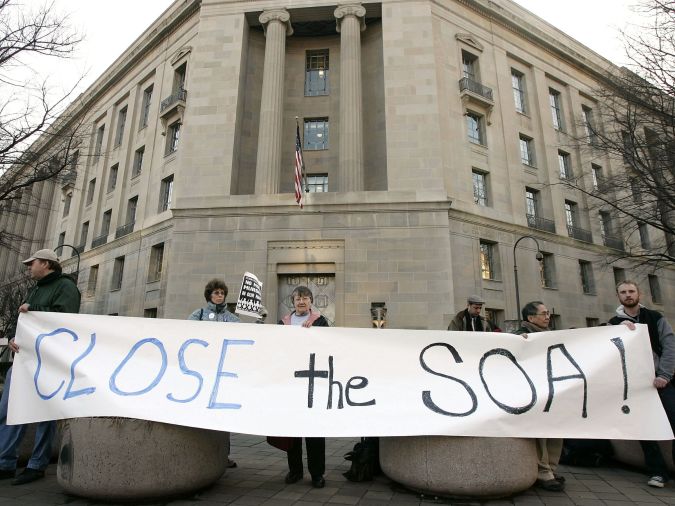Blue Beetle is filled with a lot of references that will speak to Latine audiences, from El Chapulín Colorado to María la del Barrio. But among the lighthearted nods to the culture of our communities, there is a more sinister story that ends up being a key plot point. Near the climax of the movie, Blue Beetle reveals through a series of flashbacks that the “villain,” Ignacio Carapax, was orphaned as a child when Kord Industries bombed his village in Guatemala, killing his mother. Then, Carapax was recruited into La Escuela de las Américas or the School of the Americas.
Known today as the Western Hemisphere Institute for Security Cooperation (WHINSEC), the School of the Americas has an alarming history. Founded in 1946 at Fort Amador in the Panama Canal Zone, the intended purpose of the School of the Americas was to “promote military professionalism, foster cooperation among the multinational military forces in Latin America, and expand Latin American armed forces’ knowledge of United States customs and traditions.” It soon became more than that, and the school was responsible for training over 60,000 Latin American military, law enforcement, and security personnel until its “closure” in 2000 and subsequent name change.

But even that sounds benign. Graduates from the School of the Americas didn’t just go back to their countries to help keep the peace. Instead, they went on to become the dictators, assassins, and death squad operatives responsible for a very dark era in Latin America. Leader of the Panamanian “revolution,” Omar Torrijos, and the man who would later replace him as the dictator of the Central American country, Manuel Antonio Noriega, were both graduates of the School of the Americas. So were Argentinian dictators Jorge Videla and Leopoldo Galtieri, Bolivian dictator Hugo Banzer Suarez, and Guatemalan dictator Efraín Ríos Montt.
The influence of the School of the Americas isn’t just conscripted to the figureheads. Many of the members of Pinochet’s intelligence agency that committed so many atrocities in Chile were graduates, as well as a number of Colombian military men responsible for paramilitary death squad activity and the members of El Salvador’s infamous Atlacatl Battalion.

That’s without going into what these men were taught at the School of the Americas. Declassified US military training manuals show students were instructed on repressive techniques and trained in what amounts to a laundry list of human rights violations, including treating political opposition like armed insurgencies, executing guerillas, false imprisonment, physical abuse, and paying bounties for dead enemies, among others. Basically, a US-made school for all the issues that the US would condemn in Latin America in later years.
Many of the issues with the School of the Americas were reported at the time the school nominally closed, or changed its name. Because of this, it’s worth watching videos such as Inside Story Americas – The School of the Americas: Class over?, Campaign to close down School of The Americas and Stuff They Don’t Want You to Know – The School of the Americas to further educate yourself on the School of the Americas.
The reveal that Carapax’s training comes from the real-life school of would-be dictators and mercenaries makes the villain more sympathetic – and tragic. As Blue Beetle director Ángel Manuel Soto shared in his interview with Remezcla, Carapax was “a person who experienced traumas, and those traumas were weaponized so he became the person who perpetuated terror in their cities, which is exactly what the School of the Americas did.”

Blue Beetle is, in many ways, a story about the tragedies and triumphs of Latin American communities, and with context on what the school actually was, nothing makes that clearer than the movie’s link between its villain and the School of the Americas. And the ending and Carapax’s decision is, like Soto shared, not just a final revenge, but “a way of respecting and venerating our ancestors.”
Blue Beetle is in theaters now.
This piece was written during the 2023 WGA and SAG-AFTRA strikes. Without the labor of the writers and actors currently on strike, Blue Beetle being covered here wouldn’t exist.





